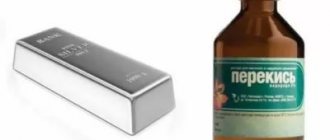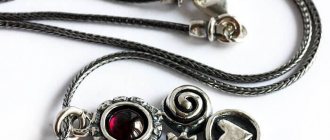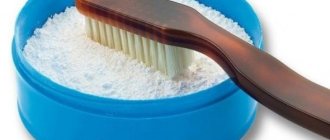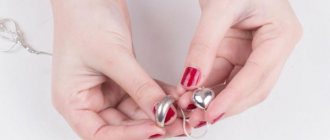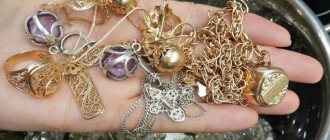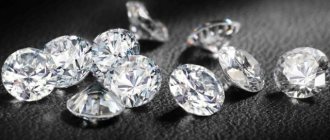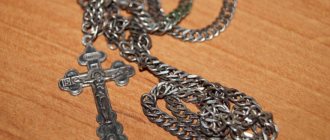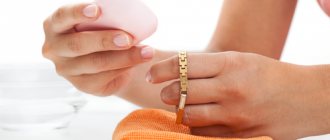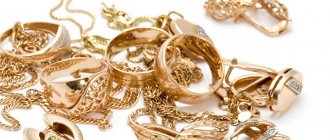Hello!
All silver items need to be cleaned periodically. There are a lot of recipes for removing blackening from metal, and everyone chooses the most convenient cleaning option for themselves.
Many people decide to clean silver with hydrogen peroxide at home, since this method is one of the most effective. However, it must be used with great care, as it can damage the product.
What is peroxide and how does it work on tarnished silver?
Hydrogen peroxide is a colorless substance with a metallic taste. When it reacts with other metals, it releases oxygen atoms to reduce or oxidize the composition. It is considered the safest for gold and silver.
Jewelry of high standard, in which the ligature content is minimal, can withstand cleaning with hydrogen peroxide without negative consequences. However, with the increase in the number of base metal additives, the risk of further blackening of the product during cleaning increases.
Is it possible to clean silver this way?
Cleaning silver jewelry is perfectly acceptable, but you should be absolutely sure that this method will not harm it. To do this, it is enough to apply a small amount of the composition to the inside of the product or lock before the procedure.
If the test gives a positive result, the metal has brightened, you can repeat the cleaning procedure with the entire item. Otherwise, it is better to use another method.
Advantages and disadvantages of this method
The popularity of cleaning with peroxide is due to the fact that the composition quickly rids the product of black deposits, making it as effective as possible. After the procedure, the surface again acquires a light color, shine, brightness and expressiveness.
The disadvantages of cleaning with hydrogen peroxide include several factors:
- requires careful use;
- with a large content of ligature, the decoration will blacken even more;
- A product damaged by peroxide cannot be restored.
Which samples can withstand this treatment?
Expert opinion
Vsevolod Kozlovsky
6 years in jewelry making. Knows everything about samples and can identify a fake in 12 seconds
Hydrogen peroxide reacts not with the silver itself, but with the alloy contained in the product. From this we can draw a logical conclusion: the higher the quality of the jewelry, the safer it is to use this cleaning method.
How to restore shine to metal
To polish cleaned silver items to a mirror shine after cleaning, removing any traces of streaks, use one of the following products:
- gel toothpaste without coloring additives;
- hygienic lipstick also without coloring ingredients;
- GOI paste;
- special wipes or sprays for silver.
Apply a little toothpaste, lipstick or GOI paste to a soft cloth (flannel or velvet are best) and rub the silver item on all sides. If you use purchased special products, follow the instructions:
- Rub the silver with cleaning wipes, without washing them, but using them until they are completely dirty;
- Spray the products on all sides and after a few minutes polish them to a shine.
Polishing silver after cleaning helps to permanently consolidate the result.
Cleaning silver with hydrogen peroxide is a proven, effective and simple method, but only suitable for high-quality silver. If you are sure that your silver jewelry or tableware is not a fake, use this affordable and affordable product to restore the elegant, refined beauty and shine of aristocratic metal.
How to clean silver with hydrogen peroxide at home
Before you begin cleaning your jewelry, you need to make sure that all safety precautions are followed. In particular, that the use of peroxide will not harm silver. It is also recommended to strictly follow the sequence of actions and proportions of recipes.
Precautionary measures
First of all, before carrying out the procedure (if it is applied to jewelry for the first time), it is necessary to check the reaction. To do this, apply a small amount of solution to the back of the product and wait 15-20 minutes. If the metal has become lighter, you can begin cleaning the entire item.
However, even in this case, do not forget about the safety rules when working with hydrogen peroxide:
- Carry out the procedure wearing gloves and safety glasses so that the solution does not accidentally come into contact with the skin or mucous membranes.
- If you do get peroxide on your hands, wash the area thoroughly with plenty of soap and water.
- For greater convenience and safety, use tweezers.
- Breathing peroxide fumes is strictly prohibited. If it gets on the mucous membrane, it can cause burns.
- It is recommended to carry out the cleaning procedure in a room with good ventilation.
Cleaning Solution Recipes
- Add a spoonful of baking soda to the container and add hydrogen peroxide so that the mixture resembles thick sour cream. Using a soft cloth, take some of the solution and apply it to the silver. Wipe the dirty areas well until the stains and stains disappear. After cleaning, rinse the silver with running water and dry thoroughly.
- If the surface of the jewelry is embossed, soda and hydrogen peroxide are taken in equal parts and mixed. Silver items are placed in the resulting mixture. They must lie in the solution for at least 15 minutes. After this, they are wiped with a soft cloth, washed with clean water and dried.
- Silverware and jewelry can be cleaned with a mixture of ammonia and peroxide. To do this, take 2 tablespoons of each ingredient and mix it in a liter of water. The silver is soaked in the composition for 15 minutes, then washed with water and dried.
Preparation of the solution
It is recommended to prepare the cleaning solution in a small, deep container. If you plan to soak the items for a certain time, it is important to choose a container in which all the silver will be evenly covered with the composition.
Never mix the ingredients or apply them to the metal with your bare hands.
Preparing Jewelry for Cleaning
Before cleaning, it is important to remove any grease particles from the surface of the silver. To do this, make a solution based on dishwashing detergent or shampoo. The products should lie in it for 15-20 minutes. Then wipe them with a cloth and rinse with clean water. Next, proceed with the procedure.
Cleaning process
Clean jewelry only with cloths and soft-bristled brushes. Otherwise, the surface may be damaged to the point of scratches. It is recommended to make all solutions using warm water.
Methods of carrying out the procedure
Hydrogen peroxide and soda
- Pour a tablespoon of soda into a glass container and add peroxide little by little until you get a paste that resembles sour cream.
- Immerse silver items in the resulting composition and leave for 15-25 minutes.
- After the time has passed, remove, wipe with a soft cloth and rinse in running water.
Hydrogen peroxide and ammonia
- Dilute 1 tbsp in 0.5 liters of cold water. l. peroxide and the same amount of ammonia.
- Soak silver items in the solution for 15 minutes, then rinse in running water.
High sterling silver
If the silver is guaranteed to be of the highest standard, it is permissible to use a more concentrated composition without the use of water.
To do this, mix one part of ammonia with two parts of 3% hydrogen peroxide.
Cleaning will be faster and more efficient, but this composition does not eliminate the need for a preliminary test with a drop in an inconspicuous place.
Other cleaning methods
There are safer ways to clean the surface of silver items:
- solution based on tooth powder;
- composition of ammonia and white chalk;
- a mixture of soda, food foil, water;
- soap solution;
- a mixture of vinegar and citric acid;
- cleaning with GOI paste.
See below how you can clean silver with ammonia or ammonia:
Advantages and disadvantages
Due to the fact that peroxide does an excellent job of cleaning silver items from plaque and dirt, even jewelers use this product. After washing, the light shade, shine and brightness return.
Pros:
- high efficiency;
- ease of use;
- safety at work;
- low cost of the product.
- requires accuracy;
- can ruin an item with a low standard;
- with frequent use of the product, the silver will darken even more;
- If jewelry or cutlery is damaged, the quality of the metal cannot be restored.
How to clean jewelry with stones
Before you begin cleaning, you should make sure that the selected method will not harm the mineral. Depending on the structure, density and origin, stones cannot be treated with water, aggressive agents, acids, etc.
It is better to use special jewelry wipes to clean silver jewelry with stones. They can be purchased at a jewelry store. The napkin easily removes traces of grease and other contaminants. With its help, you can clean not only stones, but also the metal part of the jewelry yourself.
Cleansing heavy stains
If the jewelry is very dark or has a greasy coating, it should be washed several times. Before using peroxide, the item must be soaked in a soapy solution and rinsed in hard-to-reach areas.
You can use a soft toothbrush and use it to clean out any stubborn stains. To clean, use soap, dishwashing detergent or regular toothpaste.
If the silver does not brighten at all, you can boil it for 2-3 minutes in a solution of ammonia, peroxide and soap.
Rules for wearing, caring for and storing silver items
In order not to resort to dubious and dangerous methods of restoring silver, it is recommended to be careful when wearing and storing it. In this case, the risk of metal blackening is significantly reduced.
We recommend adhering to the following rules:
- do not store silver, gold or other metals in the same box;
- remove jewelry before visiting water procedures (sauna, steam bath, swimming in the sea);
- before sports activities, put jewelry in a locker or bag and wear it only when showering;
- apply cosmetics and perfume to your skin before taking jewelry;
- Avoid wearing silver while cleaning around the house.
How to clean a gold plated chain
Gold plating is a thin layer of aurum applied to silver or any other metal. You can clean a gold-plated chain using methods that are relevant for caring for gold. But there is one significant “but”: the gold layer on such products is very thin, so any abrasive and aggressive chemical influences can lead to damage, even abrasion.
Jewelry workshops have special ultrasonic washers that are absolutely safe for jewelry. If you are worried about the safety of your favorite chain or simply don’t want to bother with cleaning it, go there. The ultrasonic cleaning procedure is inexpensive, but the effect of pristine radiance is guaranteed!
At home, you can get by with the usual soap solution described above. A good option is to soak the product in beer, beaten egg whites or grated potatoes for half an hour, rinse and dry.
Care Tips
The process of purifying silver requires additional time, effort, and money. In order not to incur such losses, it is easier to consider a few simple but important tips that will help avoid darkening on the metal:
- Ensure that silver items are stored in a dry place; it is better to exclude the presence of other metals.
- Protect items from exposure to sunlight.
- Storage packaging should not contain sulfur, as it enhances oxidation processes.
- If you wear silver jewelry, remove it before showering or coloring your hair.
- If your silver needs to be stored for a long time, wrap it in foil.
Is it possible to clean silver using this method?
Using hydrogen peroxide, or hydrogen peroxide, you can perfectly clean high-quality silver containing a minimum of standard impurities. For example, 925 metal standard means that the alloy contains 92.5% pure silver and 7.5% impurities, or alloys. Alloying silver increases its strength and removes some of the disadvantages of pure metal. The classic additive to 925 silver is copper.
If the decoration or product is made from an alloy of low standard or with a violation of technology, that is, with the addition of any other metals, peroxide, entering into a chemical reaction with them, can, on the contrary, cause darkening of the silver. Therefore, before you start “full-scale” cleaning of silver items with this product at home, test its effect on small areas on the back side.
When reacting with metals, hydrogen peroxide releases oxygen atoms that oxidize them. This destroys the plaque film that causes visible darkening of the silver.
Advantages of this cleaning method:
- availability and low cost of all components;
- simplicity of the process;
- excellent results if the rules are followed.
The disadvantages are few, but they are worth paying attention to:
- due to the low quality of silver, you can further ruin its appearance;
- Products with precious stones and other inserts should not be cleaned with peroxide;
- You cannot clean blackened silver with peroxide.
Don't take risks with cleaning antiques with home remedies. Their cost is usually high, and the composition of the alloy is unknown.
Recommendations
Hydrogen peroxide fumes are harmful to the respiratory system, so it is advisable to clean them in a well-ventilated area or in the air, for example, on a balcony. The same applies to ammonia, which has an extremely pungent and unpleasant odor.
To prepare solutions, you must use a glass or plastic rod, and never use your bare hands. It is better to manipulate the product in solution with tweezers.
After the described cleaning procedure, the jewelry will again acquire its shine and its inherent matte shine. And with a gentle wear regime, which implies minimal contact of silver with cosmetics, household chemicals, hot water, etc., the next cleaning will not be needed soon.
Source
Why do silver things turn black?
Silver jewelry is no less popular than gold jewelry. If yellow metal is compared to the color of the sun, then silver products are more likely to resemble the cold shine of the midnight moon. Jewelry made from it adds charm and elegance to its owners.
Despite all the positive qualities of durable and beautiful metal, the formation of a dark coating on the surface is considered a serious drawback.
There may be several reasons for this:
- Excessive humidity. When visiting a sauna, swimming pool or just taking a bath, try to remove jewelry from your body. When in contact with water, silver darkens faster than in fresh air.
- Excessive sweating. Human body secretions can also cause patina. Often such phenomena signal the need to see a doctor due to serious problems in the body.
- Reaction with sulfur. Silver things are not very friendly with this chemical element. An unwanted reaction can happen if sulfur is present in your cosmetics or detergents.
